Project 02: Car Crash Exploratory Data Analysis
This project uses exploratory data analysis to visualize underlying car crash data for Southeast Michigan. This step uses python, pandas, matplotlib, and seaborn to highlight trends that exist within the data.
import pandas as pd
df = pd.read_csv('combined_dataset.csv')
#df = pd.read_csv('crash_funding_data.csv')
/Users/connorlockman/anaconda3/lib/python3.7/site-packages/IPython/core/interactiveshell.py:3057: DtypeWarning: Columns (28,48,49) have mixed types. Specify dtype option on import or set low_memory=False.
interactivity=interactivity, compiler=compiler, result=result)
df.head()
| Unnamed: 0 | ACOUNT | ALCOHOL | BCOUNT | BICYCLE | CARTODB_ID | CCOUNT | CNTNAME | COMMERCIAL | COMMUNITY | ... | UNITS | WEATHER | WEEKDAY | WORK_ZONE | X | XCORD | Y | YCORD | YEAR | YOUNG | |
|---|---|---|---|---|---|---|---|---|---|---|---|---|---|---|---|---|---|---|---|---|---|
| 0 | 0 | 0 | 0 | 0 | 0 | NaN | 0 | Washtenaw | NaN | Ann Arbor | ... | 2 | 5 | 2 | NaN | -83.771023 | -83.77102 | 42.287878 | 42.28787 | 2017 | 0 |
| 1 | 1 | 0 | 0 | 0 | 0 | NaN | 0 | Oakland | NaN | Brandon Twp | ... | 1 | 5 | 2 | NaN | -83.421944 | -83.42194 | 42.810271 | 42.81026 | 2017 | 1 |
| 2 | 2 | 0 | 0 | 0 | 0 | NaN | 0 | Oakland | NaN | Bloomfield Twp | ... | 1 | 5 | 2 | NaN | -83.234323 | -83.23432 | 42.615461 | 42.61546 | 2017 | 1 |
| 3 | 3 | 0 | 0 | 0 | 0 | NaN | 0 | Oakland | NaN | Orchard Lake Village | ... | 2 | 2 | 3 | NaN | -83.362812 | -83.36281 | 42.578827 | 42.57882 | 2017 | 0 |
| 4 | 4 | 0 | 0 | 0 | 0 | NaN | 0 | Livingston | NaN | Hartland Twp | ... | 2 | 2 | 5 | NaN | -83.753034 | -83.75303 | 42.656270 | 42.65626 | 2017 | 0 |
5 rows × 61 columns
What does our combined dataset look like?
len(df)
709900
We have 709,900 crash cases in this dataset.
what about the distribution among years?
import numpy as np
import pandas as pd
import seaborn as sns
import matplotlib.pyplot as plt
from scipy import stats
sns.set(color_codes=True)
x = df['YEAR']
yr_2014 = len(df.loc[df['YEAR'] == 2014])
yr_2015 = len(df.loc[df['YEAR'] == 2015])
yr_2016 = len(df.loc[df['YEAR'] == 2016])
yr_2017 = len(df.loc[df['YEAR'] == 2017])
yr_2018 = len(df.loc[df['YEAR'] == 2018])
yr_2017
145362
x_axis = ['2014','2015','2016','2017','2018']
y_axis = [yr_2014,yr_2015,yr_2016,yr_2017,yr_2018]
sns.barplot(x=x_axis, y=y_axis)
<matplotlib.axes._subplots.AxesSubplot at 0x10a7701d0>
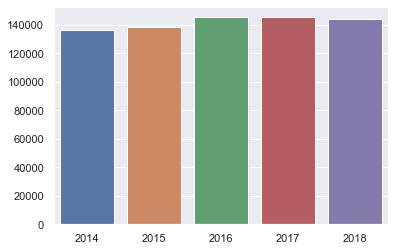
We see that each year has a very similar total number of car crashes.
When are these car crashes occuring?
Let’s look at the aggregate day counts
dates_result = df.groupby('DATE_FULL').size().sort_values(ascending=True)
dates_result
DATE_FULL
12/25/2014 136
01/01/2015 155
01/03/2016 155
12/25/2015 156
03/23/2014 160
07/06/2014 162
03/30/2014 163
12/25/2016 169
04/13/2014 172
07/05/2015 174
04/27/2014 176
04/05/2015 181
04/20/2014 183
04/06/2014 185
01/12/2014 185
09/09/2018 186
03/04/2018 186
02/25/2018 188
03/11/2018 188
12/07/2014 188
03/16/2014 189
03/29/2015 190
12/28/2014 191
02/19/2017 191
12/27/2015 192
11/26/2015 192
12/25/2018 193
07/16/2017 193
12/14/2014 193
04/22/2018 194
...
10/31/2014 768
11/20/2018 778
12/24/2017 780
12/11/2016 794
01/10/2017 795
12/18/2015 796
02/09/2018 797
01/16/2014 797
01/31/2017 818
01/02/2014 832
02/09/2016 845
04/17/2018 848
12/13/2017 870
03/01/2016 872
02/05/2014 874
01/09/2015 879
01/03/2014 913
11/21/2015 917
03/13/2014 941
12/09/2017 965
01/08/2014 982
01/09/2018 992
01/29/2018 993
12/08/2016 1007
12/11/2017 1018
03/12/2014 1021
02/24/2016 1126
11/19/2014 1287
01/07/2014 1313
03/13/2017 1369
Length: 1826, dtype: int64
We see that the most car crashes in this dataset occurred on March 13th of 2017. With a little investigation we see that the bottom of the list makes sense with christmas day emerging as one the days with the least number of car crashes. Days at the top of this list mainly fall in the winter months and we can see that with some investigation that these days typically had wintery conditions with snow, ice, or very low temperatures occuring.
fig, ax = plt.subplots(figsize=(15,7))
result_dates = df.groupby('DATE_FULL').size().plot(ax=ax)
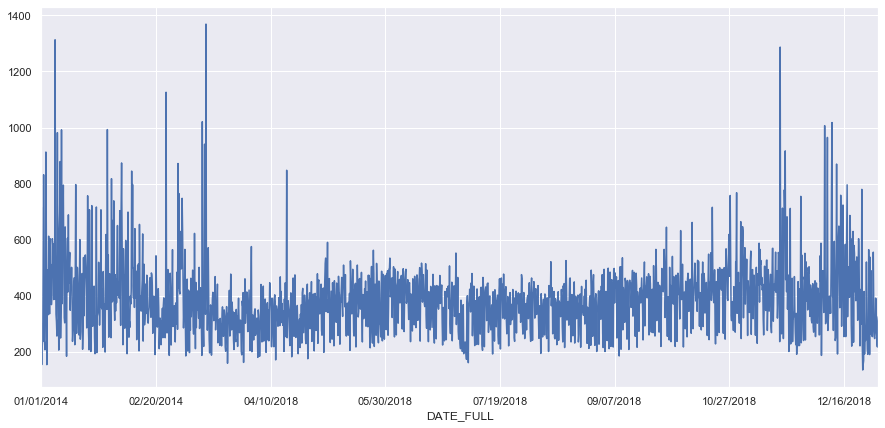
Let’s look at the hourly distribution of crashes
fig, ax = plt.subplots(figsize=(15,7))
df.groupby('HOUR').size().plot(ax=ax)
<matplotlib.axes._subplots.AxesSubplot at 0x116c99b38>
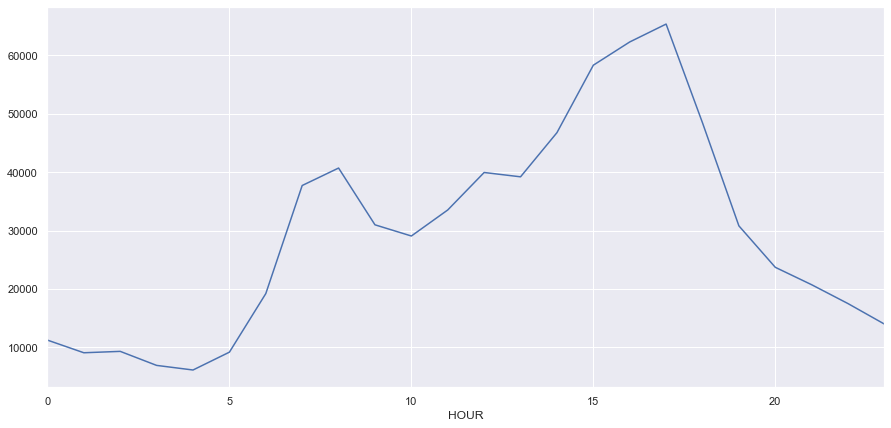
We can see in this figure that their is a bimodial distribution of crashes with a spike in the morning during the traditional morning rush hour times of 6 - 9 and a larger spike in the afternoon around 5 - 7 pm during the evening rush hour period. Intuitively, this makes sense.
Which city has the most car crashes and the least?
df.groupby('COMMUNITY').size().sort_values(ascending =True)
COMMUNITY
Novi Twp 1
Southfield Twp 1
Fenton (Livingston) 1
Estral Beach 5
Grosse Pointe Shores (Macomb) 11
Lake Angelus 14
Leonard 17
Memphis (St. Clair) 17
Barton Hills 21
Petersburg 22
Maybee 29
Emmett 39
Richmond (St. Clair) 39
Memphis (Macomb) 44
Armada 61
Luna Pier 76
Carleton 89
Yale 98
Algonac 124
Capac 128
Freedom Twp 140
Milan (Monroe) 143
East China Twp 153
Manchester 154
Ortonville 170
Grosse Pointe Shores (Wayne) 176
Pinckney 199
South Rockwood 199
River Rouge 218
Grant Twp 218
...
Redford Twp 6079
Dearborn Heights 6163
Ypsilanti Twp 6341
Pittsfield Twp 6852
St. Clair Shores 7470
Madison Heights 7511
West Bloomfield Twp 7684
Bloomfield Twp 7948
Westland 8590
Waterford Twp 9357
Shelby Twp 9407
Macomb Twp 9426
Roseville 9626
Novi 10128
Pontiac 10160
Auburn Hills 10435
Royal Oak 10582
Canton Twp 10609
Taylor 11847
Clinton Twp 11957
Rochester Hills 11959
Farmington Hills 15760
Troy 17085
Dearborn 17505
Southfield 18002
Ann Arbor 18250
Livonia 18341
Warren 23681
Sterling Heights 23796
Detroit 115539
Length: 237, dtype: int64
237 cities featured crash data for the region
We see that Detroit emerges as the city with the most crashes. We can believe this because it is clearly the largest city in South East Michigan with a population close to 675,000. It is also the economic center of the region and has many of the areas jobs. Cities that fall to the bottom of the list have, generally smaller populations. For insantance, Barton Hills which is located just to the west of ann arbor had 21 crashes and has a population of 320. These results pose a question of how to normalize this data and whether that should be by total population or number of jobs in the region. We decide to rely on the raw data because we don’t have an indication about which is the appropriate normalization process.
County
df.groupby('CNTNAME').size().sort_values(ascending =False)
CNTNAME
Wayne 260891
Oakland 204977
Macomb 125741
Washtenaw 56091
Livingston 24111
Monroe 19052
St. Clair 19037
dtype: int64
pop = [1.75,1.25,.871,.368,.189,.149,.159]
county = ['Wayne','Oakland','Macomb','Washtenaw','Livingston','Monroe','St. Clair']
sns.barplot(x=pop, y=county)
<matplotlib.axes._subplots.AxesSubplot at 0x1162a79b0>
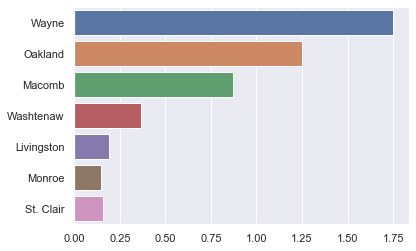
Who is involved in these car crashes?
who_df = df[['PEDESTRIAN', 'BICYCLE', 'MOTORCYCLE',
'TRAIN', 'DISTRACTED','ELDERLY','YOUNG']]
who_df.head()
| PEDESTRIAN | BICYCLE | MOTORCYCLE | TRAIN | DISTRACTED | ELDERLY | YOUNG | |
|---|---|---|---|---|---|---|---|
| 0 | 0 | 0 | 0 | 0 | 0 | 0 | 0 |
| 1 | 0 | 0 | 0 | 0 | 0 | 0 | 1 |
| 2 | 0 | 0 | 0 | 0 | 1 | 0 | 1 |
| 3 | 0 | 0 | 0 | 0 | 0 | 0 | 0 |
| 4 | 0 | 0 | 0 | 0 | 0 | 0 | 0 |
ped_lst = df.loc[who_df['PEDESTRIAN']==1]
ped = len(ped_lst)
ped / 709000
0.008899858956276445
bike_lst = df.loc[who_df['BICYCLE']==1]
bike = len(bike_lst)
moto_lst = df.loc[df['MOTORCYCLE']==1]
moto = len(moto_lst)
train_lst = df.loc[df['TRAIN']==1]
train = len(train_lst)
distracted_lst = df.loc[df['DISTRACTED']==1]
distracted = len(distracted_lst)
young_lst = df.loc[df['YOUNG']==1]
young = len(young_lst)
young / 709000
0.3330253878702398
old_lst = df.loc[df['ELDERLY']==1]
old = len(old_lst)
x_axis = ['ped','bike','moto','train']
y_axis = [ped, bike,moto,train]
sns.barplot(x=x_axis, y=y_axis)
<matplotlib.axes._subplots.AxesSubplot at 0x1181a75f8>
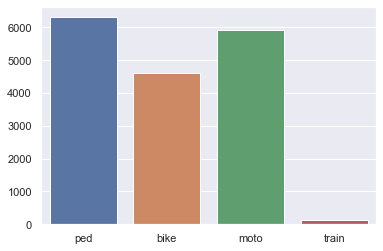
We can see here that pedestrians are involved in the most crash instances while trains are fairly rare in the crash data.
x_axis = ['old','young','distracted']
y_axis = [old, young,distracted]
sns.barplot(x=x_axis, y=y_axis)
<matplotlib.axes._subplots.AxesSubplot at 0x119e3c0b8>
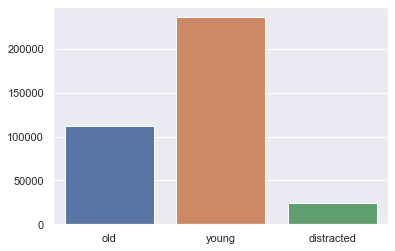
old + young + distracted
372701
709900 - 372701
337199
We see that with using some of the demographic features that we are still 337,199 crash accounts short. This builds insight into that while we do know a little about who is involved in these crashes, we don’t have full understanding about them across the board.
Weather
How does weathe impact this car crash data?
df.groupby('WEATHER').size().sort_values(ascending =False)
WEATHER
1 436696
2 142019
4 63503
5 47649
98 11278
3 3289
7 2354
8 2000
6 1019
9 42
10 27
0 24
dtype: int64
1 = clear
2 = cloudy
3 = FOG
4 = RAIN
5 = SNOW
6 = SEVERE CROSSWINDS
7 = SLEET / HAIL
8 = BLOWING SNOW
9 = BLOWING SAND SOIL DIRT
10 = SMOKE
98 = UNKNOWN
0 = NOT ENTERED
Y = [436696,142019,63503,47649,11278,3289,2354,2000,1019,42,27,24]
#X = [1,2,4,5,98,3,7,8,6,9,10,0]
X = ['CLEAR','CLOUDY','FOG','RAIN','SNOW','SEVERE CROSSWINDS','SLEET / HAIL','BLOWING SNOW','BLOWING SAND SOIL DIRT','SMOKE','UNKNOWN','NOT ENTERED']
sum(Y)
709900
Every case in the data has a weather code assigned to it.
sns.barplot(x=X, y=Y)
plt.xticks(rotation='vertical')
(array([ 0, 1, 2, 3, 4, 5, 6, 7, 8, 9, 10, 11]),
<a list of 12 Text xticklabel objects>)

The vast majority of crashes occur under clear or cloudy circumstances.
Road Conditions
Weather doesn’t seem to be a major factor, but could road factors be impacting the data?
df.columns
Index(['Unnamed: 0', 'ACOUNT', 'ALCOHOL', 'BCOUNT', 'BICYCLE', 'CARTODB_ID',
'CCOUNT', 'CNTNAME', 'COMMERCIAL', 'COMMUNITY', 'CRASHID', 'CRSHTYPEO',
'DATE_FULL', 'DAY', 'DEER', 'DISTRACTED', 'DIS_CTRL_I', 'DRUG',
'ELDERLY', 'EMERGENCY', 'FALINKID', 'FID', 'HIGH_SEVER', 'HITNRUN',
'HOUR', 'HWY_CLSS_C', 'INTERROAD', 'INTR_INVL_', 'JURIS', 'KCOUNT',
'LANEDEPART', 'LIGHTING', 'MAINROAD', 'MONTH', 'MOTORCYCLE', 'MP',
'NFC', 'OBJECTID', 'OCCUPANTS', 'PEDESTRIAN', 'PR', 'PROPDAMG',
'REDLIGHTRU', 'ROADCONDIT', 'ROADLANES', 'SCHOOLBUS', 'SEMMCD',
'SPEEDLIMIT', 'SURFACE', 'TIME_FULL', 'TRAIN', 'UNITS', 'WEATHER',
'WEEKDAY', 'WORK_ZONE', 'X', 'XCORD', 'Y', 'YCORD', 'YEAR', 'YOUNG'],
dtype='object')
df.groupby('WORK_ZONE').size().sort_values(ascending =False)
WORK_ZONE
0.0 141201
1.0 2743
dtype: int64
2743 + 141201
143944
We can’t be certain of anything about workzones because it appears that we dont have data for many of the years in question
df.groupby('ROADCONDIT').size().sort_values(ascending =False)
ROADCONDIT
1 500506
2 114178
4 41835
3 34048
6 6193
98 4955
97 3390
8 2250
5 2185
7 254
10 47
0 38
9 21
dtype: int64
1 = dry
2 = wet
3 = ice
4 = snow
5 = Mud, Dirt, Gravel
6 = slush
7 = debris
8 = Water (Standing/Moving)
9 = Sand
10 = Oily
97 = other
98 = unknown
0 = null / not entered
Y = [500506,114178,41835,34048,6193,4955,3390,2250,2185,254,47,38,21]
X = ['dry','wet','ice','snow','Mud, Dirt, Gravel', 'Slush','debris','Water (Standing/Moving)','Sand','Oily','other','unknown','null / not entered']
sns.barplot(x=X, y=Y)
plt.xticks(rotation='vertical')
(array([ 0, 1, 2, 3, 4, 5, 6, 7, 8, 9, 10, 11, 12]),
<a list of 13 Text xticklabel objects>)
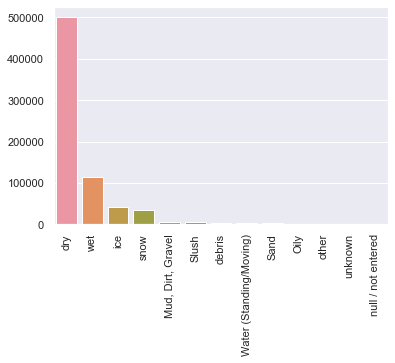
df.groupby('HWY_CLSS_C').size().sort_values(ascending =False)
HWY_CLSS_C
9 420484
3 129568
1 103871
2 41057
4 9031
5 4076
7 1079
0 734
dtype: int64
df.groupby('ROADLANES').size().sort_values(ascending =False)
ROADLANES
2 252048
5 134424
3 132193
4 125930
1 24694
6 23295
7 12496
8 4144
9 632
0 40
-2 2
-4 2
dtype: int64
df.groupby('SPEEDLIMIT').size().sort_values(ascending =False)
SPEEDLIMIT
45 160483
25 114022
35 95293
70 86459
40 82383
55 73438
50 49487
30 33187
0 8746
15 2520
60 1406
20 923
65 781
10 355
5 216
75 195
46 2
26 1
23 1
8 1
80 1
dtype: int64
df.groupby('SURFACE').size().sort_values(ascending =False)
SURFACE
Asphalt 91780
Concrete 39784
10760
Gravel 1609
Brick 11
dtype: int64
Road Funding
We are interested in building road funding into this data and conducting some analysis on this
df_funding = pd.read_csv('community.csv')
df_funding.head()
| County | Community | Annual Amount | Road Miles | Average Per Mile | Unnamed: 5 | Unnamed: 6 | |
|---|---|---|---|---|---|---|---|
| 0 | Livingston | Brighton | $465,346 | 29.44 | $15,807 | NaN | NaN |
| 1 | Livingston | Fowlerville | $207,751 | 13.84 | $15,011 | NaN | NaN |
| 2 | Livingston | Howell | $576,420 | 36.64 | $15,732 | NaN | NaN |
| 3 | Livingston | Pinckney | $150,719 | 11.37 | $13,256 | NaN | NaN |
| 4 | Macomb | Armada | $106,664 | 7.21 | $14,794 | NaN | NaN |
df_funding = df_funding.rename(columns={'Community': 'COMMUNITY'})
df_funding.loc[df_funding['COMMUNITY']=='Brandon Twp']
| County | COMMUNITY | Annual Amount | Road Miles | Average Per Mile | Unnamed: 5 | Unnamed: 6 |
|---|
Not all the cities from our original crash data are represented in our funding data
len(df_funding)
120
result = pd.merge(df,df_funding,how='left', on='COMMUNITY')
result.head()
| Unnamed: 0 | ACOUNT | ALCOHOL | BCOUNT | BICYCLE | CARTODB_ID | CCOUNT | CNTNAME | COMMERCIAL | COMMUNITY | ... | Y | YCORD | YEAR | YOUNG | County | Annual Amount | Road Miles | Average Per Mile | Unnamed: 5 | Unnamed: 6 | |
|---|---|---|---|---|---|---|---|---|---|---|---|---|---|---|---|---|---|---|---|---|---|
| 0 | 0 | 0 | 0 | 0 | 0 | NaN | 0 | Washtenaw | NaN | Ann Arbor | ... | 42.287878 | 42.28787 | 2017 | 0 | Washtenaw | $7,535,530 | 296.70 | $25,398 | NaN | NaN |
| 1 | 1 | 0 | 0 | 0 | 0 | NaN | 0 | Oakland | NaN | Brandon Twp | ... | 42.810271 | 42.81026 | 2017 | 1 | NaN | NaN | NaN | NaN | NaN | NaN |
| 2 | 2 | 0 | 0 | 0 | 0 | NaN | 0 | Oakland | NaN | Bloomfield Twp | ... | 42.615461 | 42.61546 | 2017 | 1 | NaN | NaN | NaN | NaN | NaN | NaN |
| 3 | 3 | 0 | 0 | 0 | 0 | NaN | 0 | Oakland | NaN | Orchard Lake Village | ... | 42.578827 | 42.57882 | 2017 | 0 | NaN | NaN | NaN | NaN | NaN | NaN |
| 4 | 4 | 0 | 0 | 0 | 0 | NaN | 0 | Livingston | NaN | Hartland Twp | ... | 42.656270 | 42.65626 | 2017 | 0 | NaN | NaN | NaN | NaN | NaN | NaN |
5 rows × 67 columns
len(result)
709900
result.groupby('Average Per Mile').size().sort_values(ascending =False)
Average Per Mile
$21,086 115539
$21,519 23796
$20,750 23681
$17,127 18341
$25,398 18250
$20,736 18002
$24,417 17505
$16,196 17085
$17,714 15760
$17,795 11959
$20,205 11847
$18,210 10582
$19,761 10435
$18,627 10160
$19,849 10128
$22,508 9626
$22,851 8590
$18,385 7511
$18,710 7470
$18,235 6163
$14,372 5958
$20,253 5766
$16,871 4704
$18,874 4606
$20,474 4391
$32,256 4312
$20,791 4300
$14,715 3923
$16,188 3745
$19,519 3343
...
$17,430 530
$15,920 529
$14,503 494
$14,983 474
$17,953 463
$18,172 459
$13,952 401
$17,990 359
$12,525 343
$16,313 298
$13,131 290
$13,965 266
$11,944 224
$15,011 219
$16,727 218
$13,256 199
$11,354 199
$13,864 170
$10,463 154
$13,948 128
$13,452 124
$12,711 98
$14,614 89
$9,113 76
$14,794 61
$7,884 39
$10,603 29
$11,498 22
$10,925 17
$8,188 5
Length: 103, dtype: int64
fig, ax = plt.subplots(figsize=(15,7))
result.groupby('Average Per Mile').size().plot(ax=ax)
<matplotlib.axes._subplots.AxesSubplot at 0x1198aa6d8>
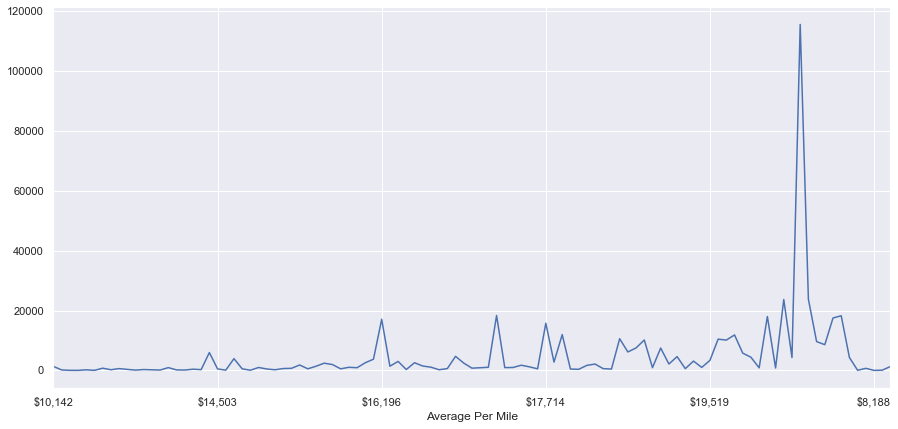
We see here that we both don’t have information for all of the cities in our crash data and that the most crashes are occuring in municipalities that fund their roads on average of 21,086. The real issue here is that the different values are so highly specific that they are just representing the different cities. We need to bin these values
result[['Currency']] = result[['Average Per Mile']].replace('[\$,]','',regex=True).astype(float)
result.head()
| Unnamed: 0 | ACOUNT | ALCOHOL | BCOUNT | BICYCLE | CARTODB_ID | CCOUNT | CNTNAME | COMMERCIAL | COMMUNITY | ... | YCORD | YEAR | YOUNG | County | Annual Amount | Road Miles | Average Per Mile | Unnamed: 5 | Unnamed: 6 | Currency | |
|---|---|---|---|---|---|---|---|---|---|---|---|---|---|---|---|---|---|---|---|---|---|
| 0 | 0 | 0 | 0 | 0 | 0 | NaN | 0 | Washtenaw | NaN | Ann Arbor | ... | 42.28787 | 2017 | 0 | Washtenaw | $7,535,530 | 296.70 | $25,398 | NaN | NaN | 25398.0 |
| 1 | 1 | 0 | 0 | 0 | 0 | NaN | 0 | Oakland | NaN | Brandon Twp | ... | 42.81026 | 2017 | 1 | NaN | NaN | NaN | NaN | NaN | NaN | NaN |
| 2 | 2 | 0 | 0 | 0 | 0 | NaN | 0 | Oakland | NaN | Bloomfield Twp | ... | 42.61546 | 2017 | 1 | NaN | NaN | NaN | NaN | NaN | NaN | NaN |
| 3 | 3 | 0 | 0 | 0 | 0 | NaN | 0 | Oakland | NaN | Orchard Lake Village | ... | 42.57882 | 2017 | 0 | NaN | NaN | NaN | NaN | NaN | NaN | NaN |
| 4 | 4 | 0 | 0 | 0 | 0 | NaN | 0 | Livingston | NaN | Hartland Twp | ... | 42.65626 | 2017 | 0 | NaN | NaN | NaN | NaN | NaN | NaN | NaN |
5 rows × 68 columns
result['bin'] = pd.cut(result['Currency'], [0, 5000, 10000,15000,20000,25000,30000])
result.head()
| Unnamed: 0 | ACOUNT | ALCOHOL | BCOUNT | BICYCLE | CARTODB_ID | CCOUNT | CNTNAME | COMMERCIAL | COMMUNITY | ... | YEAR | YOUNG | County | Annual Amount | Road Miles | Average Per Mile | Unnamed: 5 | Unnamed: 6 | Currency | bin | |
|---|---|---|---|---|---|---|---|---|---|---|---|---|---|---|---|---|---|---|---|---|---|
| 0 | 0 | 0 | 0 | 0 | 0 | NaN | 0 | Washtenaw | NaN | Ann Arbor | ... | 2017 | 0 | Washtenaw | $7,535,530 | 296.70 | $25,398 | NaN | NaN | 25398.0 | (25000.0, 30000.0] |
| 1 | 1 | 0 | 0 | 0 | 0 | NaN | 0 | Oakland | NaN | Brandon Twp | ... | 2017 | 1 | NaN | NaN | NaN | NaN | NaN | NaN | NaN | NaN |
| 2 | 2 | 0 | 0 | 0 | 0 | NaN | 0 | Oakland | NaN | Bloomfield Twp | ... | 2017 | 1 | NaN | NaN | NaN | NaN | NaN | NaN | NaN | NaN |
| 3 | 3 | 0 | 0 | 0 | 0 | NaN | 0 | Oakland | NaN | Orchard Lake Village | ... | 2017 | 0 | NaN | NaN | NaN | NaN | NaN | NaN | NaN | NaN |
| 4 | 4 | 0 | 0 | 0 | 0 | NaN | 0 | Livingston | NaN | Hartland Twp | ... | 2017 | 0 | NaN | NaN | NaN | NaN | NaN | NaN | NaN | NaN |
5 rows × 69 columns
result.groupby('bin').size().sort_values(ascending =False)
bin
(20000, 25000] 244713
(15000, 20000] 194008
(10000, 15000] 18789
(25000, 30000] 18250
(5000, 10000] 2130
(0, 5000] 0
dtype: int64
fig, ax = plt.subplots(figsize=(15,7))
result.groupby('bin').size().plot(ax=ax)
<matplotlib.axes._subplots.AxesSubplot at 0x1199966a0>
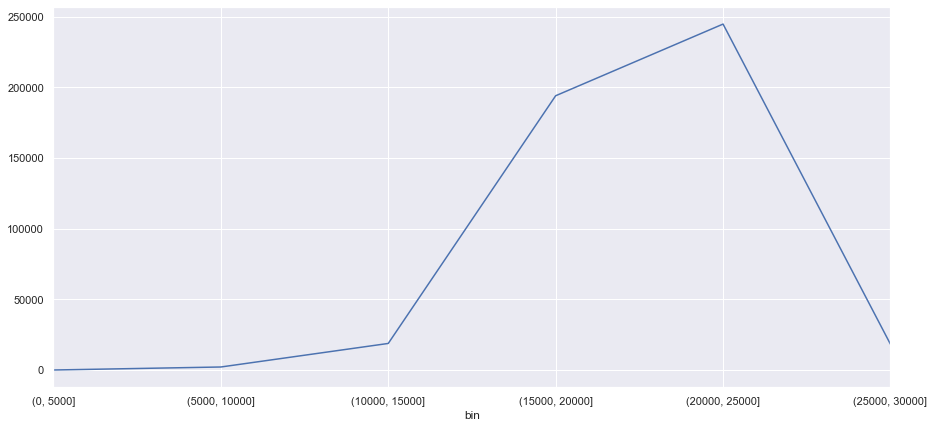
Ann Arbor
Let’s look at a specific city in our data and see if the overarching trends are represented
df_aa = df.loc[df['COMMUNITY']=='Ann Arbor']
df_aa.head()
| Unnamed: 0 | ACOUNT | ALCOHOL | BCOUNT | BICYCLE | CARTODB_ID | CCOUNT | CNTNAME | COMMERCIAL | COMMUNITY | ... | UNITS | WEATHER | WEEKDAY | WORK_ZONE | X | XCORD | Y | YCORD | YEAR | YOUNG | |
|---|---|---|---|---|---|---|---|---|---|---|---|---|---|---|---|---|---|---|---|---|---|
| 0 | 0 | 0 | 0 | 0 | 0 | NaN | 0 | Washtenaw | NaN | Ann Arbor | ... | 2 | 5 | 2 | NaN | -83.771023 | -83.77102 | 42.287878 | 42.28787 | 2017 | 0 |
| 21 | 21 | 0 | 0 | 0 | 0 | NaN | 0 | Washtenaw | NaN | Ann Arbor | ... | 2 | 1 | 4 | NaN | -83.707336 | -83.70734 | 42.302537 | 42.30253 | 2017 | 0 |
| 52 | 52 | 0 | 0 | 1 | 0 | NaN | 1 | Washtenaw | NaN | Ann Arbor | ... | 2 | 1 | 3 | NaN | -83.749675 | -83.74967 | 42.252243 | 42.25224 | 2017 | 0 |
| 121 | 121 | 0 | 0 | 1 | 0 | NaN | 0 | Washtenaw | NaN | Ann Arbor | ... | 2 | 1 | 6 | NaN | -83.739154 | -83.73915 | 42.240915 | 42.24091 | 2017 | 1 |
| 131 | 131 | 0 | 0 | 0 | 0 | NaN | 0 | Washtenaw | NaN | Ann Arbor | ... | 2 | 1 | 1 | NaN | -83.735003 | -83.73500 | 42.285408 | 42.28540 | 2017 | 0 |
5 rows × 61 columns
len(df_aa)
18250
709000 / 237
2991.5611814345993
2991.5611814345993 / 709000
0.0042194092827004225
.42 * 237
99.53999999999999
If all was equal, each city would have 2,991 crashes occur within their distinct city limits, but as mentioned above not all is equal.
237 * 2991
708867
We can see that 18,250 car cashes occurred within ann arbor city limits over the course of these five years in question.
18250 / 709000
0.025740479548660086
Each municipality should account for .4 percent of the crashes (if all was equal) but ann arbor is accounting for over 2.5 percent. This matches where ann arbor fell on our crash total list.
709000 * 0.025740479548660086
18250.0
aa_dates_result = df_aa.groupby('DATE_FULL').size().sort_values(ascending=False)
aa_dates_result
DATE_FULL
11/19/2014 48
01/01/2014 44
12/11/2017 43
03/07/2018 42
12/18/2014 39
01/27/2014 37
01/12/2018 37
03/13/2017 37
11/21/2015 36
04/17/2018 34
01/05/2015 33
02/24/2016 33
01/09/2014 32
01/28/2014 30
02/05/2014 29
02/09/2018 29
03/12/2014 28
01/29/2018 28
11/02/2017 28
01/09/2018 27
03/01/2016 26
01/16/2014 26
01/23/2014 26
11/21/2017 26
11/04/2016 25
01/29/2017 25
01/09/2015 25
11/18/2015 25
01/22/2014 25
10/31/2014 24
..
08/02/2015 2
07/26/2015 2
07/15/2018 2
07/13/2014 2
07/09/2016 2
07/04/2018 2
04/12/2014 2
07/03/2016 2
07/03/2015 2
02/17/2018 2
12/25/2016 1
04/07/2014 1
02/16/2015 1
03/16/2014 1
03/04/2018 1
01/02/2015 1
12/31/2016 1
08/28/2016 1
08/17/2014 1
11/27/2014 1
06/04/2017 1
11/26/2015 1
11/23/2017 1
11/22/2018 1
06/10/2018 1
06/21/2015 1
12/31/2017 1
07/04/2015 1
07/08/2018 1
05/24/2015 1
Length: 1823, dtype: int64
The day with the most crashes in ann arbor places third overall on the crash list for the entire region.
fig, ax = plt.subplots(figsize=(15,7))
aa_result_dates = df_aa.groupby('DATE_FULL').size().plot(ax=ax)
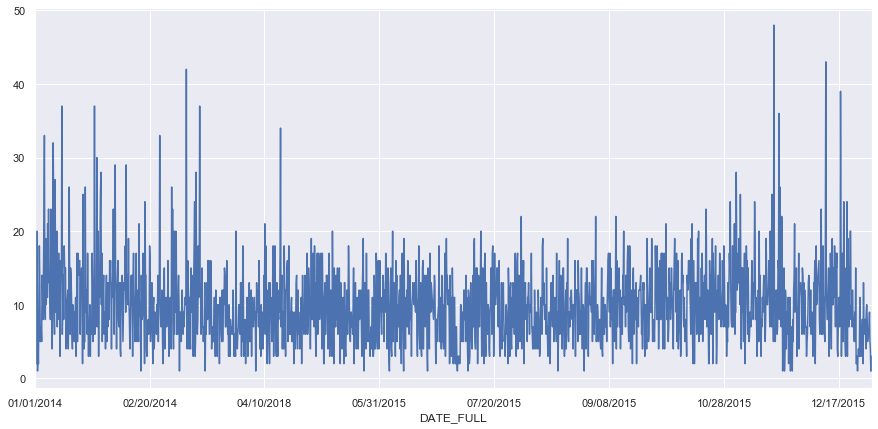
This figure follow the trends that appeared in the overall dates figure. We see spikes in car crashes on select days throughout the winter months.
fig, ax = plt.subplots(figsize=(15,7))
df_aa.groupby('HOUR').size().plot(ax=ax)
<matplotlib.axes._subplots.AxesSubplot at 0x11cfe5898>
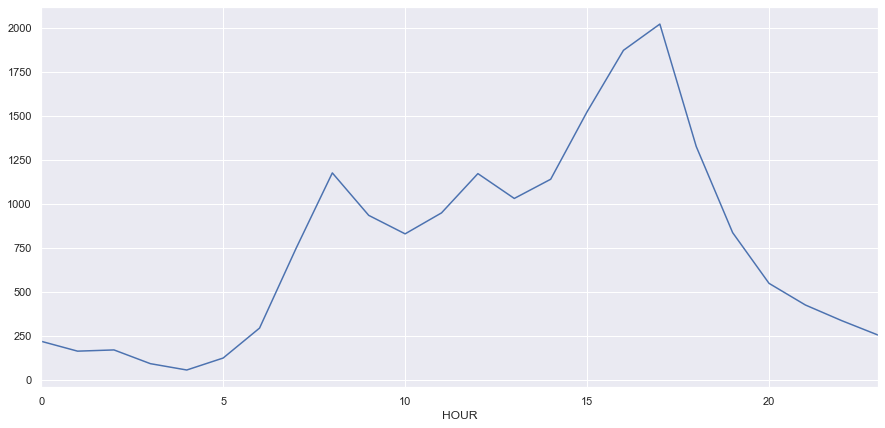
The hourly distribution of crashes within the city follows the rush hour trend we identified in the total data
Ultimately, this sub sample of data seems to be representative of the full data.
High severity crashes
df.columns
Index(['Unnamed: 0', 'ACOUNT', 'ALCOHOL', 'BCOUNT', 'BICYCLE', 'CARTODB_ID',
'CCOUNT', 'CNTNAME', 'COMMERCIAL', 'COMMUNITY', 'CRASHID', 'CRSHTYPEO',
'DATE_FULL', 'DAY', 'DEER', 'DISTRACTED', 'DIS_CTRL_I', 'DRUG',
'ELDERLY', 'EMERGENCY', 'FALINKID', 'FID', 'HIGH_SEVER', 'HITNRUN',
'HOUR', 'HWY_CLSS_C', 'INTERROAD', 'INTR_INVL_', 'JURIS', 'KCOUNT',
'LANEDEPART', 'LIGHTING', 'MAINROAD', 'MONTH', 'MOTORCYCLE', 'MP',
'NFC', 'OBJECTID', 'OCCUPANTS', 'PEDESTRIAN', 'PR', 'PROPDAMG',
'REDLIGHTRU', 'ROADCONDIT', 'ROADLANES', 'SCHOOLBUS', 'SEMMCD',
'SPEEDLIMIT', 'SURFACE', 'TIME_FULL', 'TRAIN', 'UNITS', 'WEATHER',
'WEEKDAY', 'WORK_ZONE', 'X', 'XCORD', 'Y', 'YCORD', 'YEAR', 'YOUNG'],
dtype='object')
sev = df.loc[df['HIGH_SEVER']==1]
len(sev)
1782
Detroit vs Livonia
Conducting some evaluation of the genralizability of clustering groups
det = result.loc[result['COMMUNITY']=='Detroit']
liv = result.loc[result['COMMUNITY']=='Livonia']
det.head()
| Unnamed: 0 | ACOUNT | ALCOHOL | BCOUNT | BICYCLE | CARTODB_ID | CCOUNT | CNTNAME | COMMERCIAL | COMMUNITY | ... | YEAR | YOUNG | County | Annual Amount | Road Miles | Average Per Mile | Unnamed: 5 | Unnamed: 6 | Currency | bin | |
|---|---|---|---|---|---|---|---|---|---|---|---|---|---|---|---|---|---|---|---|---|---|
| 16 | 16 | 0 | 0 | 0 | 0 | NaN | 0 | Wayne | NaN | Detroit | ... | 2017 | 0 | Wayne | $54,202,186 | 2,570.50 | $21,086 | NaN | NaN | 21086.0 | (20000, 25000] |
| 40 | 40 | 0 | 0 | 0 | 0 | NaN | 0 | Wayne | NaN | Detroit | ... | 2017 | 1 | Wayne | $54,202,186 | 2,570.50 | $21,086 | NaN | NaN | 21086.0 | (20000, 25000] |
| 41 | 41 | 0 | 0 | 0 | 0 | NaN | 0 | Wayne | NaN | Detroit | ... | 2017 | 0 | Wayne | $54,202,186 | 2,570.50 | $21,086 | NaN | NaN | 21086.0 | (20000, 25000] |
| 43 | 43 | 0 | 0 | 0 | 0 | NaN | 0 | Wayne | NaN | Detroit | ... | 2017 | 0 | Wayne | $54,202,186 | 2,570.50 | $21,086 | NaN | NaN | 21086.0 | (20000, 25000] |
| 60 | 60 | 0 | 0 | 0 | 0 | NaN | 2 | Wayne | NaN | Detroit | ... | 2017 | 0 | Wayne | $54,202,186 | 2,570.50 | $21,086 | NaN | NaN | 21086.0 | (20000, 25000] |
5 rows × 69 columns
len(det)
115539
len(liv)
18341
det.columns
Index(['Unnamed: 0', 'ACOUNT', 'ALCOHOL', 'BCOUNT', 'BICYCLE', 'CARTODB_ID',
'CCOUNT', 'CNTNAME', 'COMMERCIAL', 'COMMUNITY', 'CRASHID', 'CRSHTYPEO',
'DATE_FULL', 'DAY', 'DEER', 'DISTRACTED', 'DIS_CTRL_I', 'DRUG',
'ELDERLY', 'EMERGENCY', 'FALINKID', 'FID', 'HIGH_SEVER', 'HITNRUN',
'HOUR', 'HWY_CLSS_C', 'INTERROAD', 'INTR_INVL_', 'JURIS', 'KCOUNT',
'LANEDEPART', 'LIGHTING', 'MAINROAD', 'MONTH', 'MOTORCYCLE', 'MP',
'NFC', 'OBJECTID', 'OCCUPANTS', 'PEDESTRIAN', 'PR', 'PROPDAMG',
'REDLIGHTRU', 'ROADCONDIT', 'ROADLANES', 'SCHOOLBUS', 'SEMMCD',
'SPEEDLIMIT', 'SURFACE', 'TIME_FULL', 'TRAIN', 'UNITS', 'WEATHER',
'WEEKDAY', 'WORK_ZONE', 'X', 'XCORD', 'Y', 'YCORD', 'YEAR', 'YOUNG',
'County', 'Annual Amount', 'Road Miles', 'Average Per Mile',
'Unnamed: 5', 'Unnamed: 6', 'Currency', 'bin'],
dtype='object')
Let’s compare and contrast the rates at which key statistics occur.
det_bike = det.loc[det['BICYCLE']==1]
len(det_bike)
848
848 / 115539
0.007339513064852561
liv_bike = liv.loc[liv['BICYCLE']==1]
len(liv_bike)
117
117 / 18341
0.006379150537048144
det_bus = det.loc[det['SCHOOLBUS']==1]
len(det_bus)
320
320 / 115539
0.0027696275716424757
liv_bus = liv.loc[liv['SCHOOLBUS']==1]
len(liv_bus)
79
79 / 18341
0.004307289678861567
det_moto = det.loc[det['MOTORCYCLE']==1]
len(det_moto)
1068
1068 / 115539
0.009243632020356763
liv_moto = liv.loc[liv['MOTORCYCLE']==1]
len(liv_moto)
126
126 / 18341
0.006869854424513385
det_old = det.loc[det['ELDERLY']==1]
len(det_old)
13205
13205 / 115539
0.11429041276105904
liv_old = liv.loc[liv['ELDERLY']==1]
len(liv_old)
3671
3671 / 18341
0.20015266343165586
det_young = det.loc[det['YOUNG']==1]
len(det_young)
29981
29981 / 115539
0.25948813820441585
liv_young = liv.loc[liv['YOUNG']==1]
len(liv_young)
6301
6301 / 18341
0.34354724387983204
det_alc = det.loc[det['ALCOHOL']==1]
len(det_alc)
2323
2323 / 115539
0.020105765152892096
liv_alc = liv.loc[liv['ALCOHOL']==1]
len(liv_alc)
470
470 / 18341
0.025625647456518182
det_drug = det.loc[det['DRUG']==1]
len(det_drug)
626
626 / 115539
0.005418083937025593
liv_drug = liv.loc[liv['DRUG']==1]
len(liv_drug)
149
149 / 18341
0.008123875470257893
det_sev = det.loc[det['CRSHTYPEO']==1]
len(det_sev)
16170
16170 / 115539
0.13995274322955886
liv_sev = liv.loc[liv['CRSHTYPEO']==1]
len(liv_sev)
1782
1782 / 18341
0.09715936971811788
det_dis = det.loc[det['DISTRACTED']==1]
len(det_dis)
3678
3678 / 115539
0.031833406901565706
liv_dis = liv.loc[liv['DISTRACTED']==1]
len(liv_dis)
577
577 / 18341
0.03145957145193828
det['bin']
16 (20000, 25000]
40 (20000, 25000]
41 (20000, 25000]
43 (20000, 25000]
60 (20000, 25000]
68 (20000, 25000]
76 (20000, 25000]
94 (20000, 25000]
108 (20000, 25000]
109 (20000, 25000]
128 (20000, 25000]
156 (20000, 25000]
175 (20000, 25000]
179 (20000, 25000]
180 (20000, 25000]
182 (20000, 25000]
190 (20000, 25000]
192 (20000, 25000]
198 (20000, 25000]
209 (20000, 25000]
214 (20000, 25000]
218 (20000, 25000]
224 (20000, 25000]
235 (20000, 25000]
245 (20000, 25000]
247 (20000, 25000]
250 (20000, 25000]
251 (20000, 25000]
254 (20000, 25000]
258 (20000, 25000]
...
709804 (20000, 25000]
709817 (20000, 25000]
709818 (20000, 25000]
709824 (20000, 25000]
709825 (20000, 25000]
709827 (20000, 25000]
709828 (20000, 25000]
709830 (20000, 25000]
709831 (20000, 25000]
709833 (20000, 25000]
709834 (20000, 25000]
709840 (20000, 25000]
709842 (20000, 25000]
709851 (20000, 25000]
709852 (20000, 25000]
709855 (20000, 25000]
709857 (20000, 25000]
709858 (20000, 25000]
709863 (20000, 25000]
709865 (20000, 25000]
709866 (20000, 25000]
709870 (20000, 25000]
709875 (20000, 25000]
709878 (20000, 25000]
709879 (20000, 25000]
709884 (20000, 25000]
709889 (20000, 25000]
709895 (20000, 25000]
709897 (20000, 25000]
709898 (20000, 25000]
Name: bin, Length: 115539, dtype: category
Categories (6, interval[int64]): [(0, 5000] < (5000, 10000] < (10000, 15000] < (15000, 20000] < (20000, 25000] < (25000, 30000]]
liv['bin']
15 (15000, 20000]
27 (15000, 20000]
72 (15000, 20000]
98 (15000, 20000]
107 (15000, 20000]
133 (15000, 20000]
162 (15000, 20000]
178 (15000, 20000]
197 (15000, 20000]
213 (15000, 20000]
276 (15000, 20000]
285 (15000, 20000]
309 (15000, 20000]
340 (15000, 20000]
357 (15000, 20000]
371 (15000, 20000]
396 (15000, 20000]
429 (15000, 20000]
450 (15000, 20000]
451 (15000, 20000]
461 (15000, 20000]
464 (15000, 20000]
470 (15000, 20000]
476 (15000, 20000]
485 (15000, 20000]
487 (15000, 20000]
489 (15000, 20000]
495 (15000, 20000]
508 (15000, 20000]
510 (15000, 20000]
...
708660 (15000, 20000]
708677 (15000, 20000]
708718 (15000, 20000]
708720 (15000, 20000]
708787 (15000, 20000]
708864 (15000, 20000]
708902 (15000, 20000]
708924 (15000, 20000]
709028 (15000, 20000]
709042 (15000, 20000]
709079 (15000, 20000]
709081 (15000, 20000]
709092 (15000, 20000]
709093 (15000, 20000]
709149 (15000, 20000]
709162 (15000, 20000]
709220 (15000, 20000]
709269 (15000, 20000]
709323 (15000, 20000]
709337 (15000, 20000]
709427 (15000, 20000]
709441 (15000, 20000]
709443 (15000, 20000]
709590 (15000, 20000]
709618 (15000, 20000]
709794 (15000, 20000]
709822 (15000, 20000]
709850 (15000, 20000]
709853 (15000, 20000]
709881 (15000, 20000]
Name: bin, Length: 18341, dtype: category
Categories (6, interval[int64]): [(0, 5000] < (5000, 10000] < (10000, 15000] < (15000, 20000] < (20000, 25000] < (25000, 30000]]
